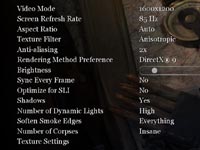XFX GeForce 8800 Ultra 650M Extreme
Written by Tim Smalley
June 15, 2007 | 12:45
Tags: #8800 #consumption #drop #efficiency #evaluation #extreme #frame #geforce #overclocking #performance #power #price #rate #review #xt

Call of Duty 2
Publisher: ActivisionWe used the full version of Call of Duty 2, patched to version 1.2. The game makes use of some awesome effects and is generally very graphically intense and immersive. That's helped by the tremendous smoke effect that Infinity Ward has created -- it's better than anything we've ever seen before. There are also real time shadows and subtle HDR lighting effects too.
The gameplay is not as linear as the first version of Call of Duty, and Infinity Ward has ditched the rather old Quake 3 engine in favour of creating its own proprietary graphics engine to render the effects. There is something about the game that makes it very intense and you often find yourself having to take a break from the action because you're too overwhelmed by its immersiveness and intensity.
We used a custom timedemo that covers both indoor and outdoor performance in the title across one of the most intensive portions of the game. The Optimise for SLI option was disabled for single GPU configurations as it causes some texture corruption if there is only one GPU present. It was enabled for dual-GPU configurations and all other options were set to their maximum values.
Call Of Duty 2
1600x1200 4xAA 8xAF, Maximum Quality
- Nvidia GeForce 8800 GTX 768MB SLI
- ATI Radeon X1950 XTX 512MB CrossFire
- BFGTech GeForce 8800 GTS OC 640MB SLI
- ATI Radeon HD 2900 XT 512MB CrossFire
- XFX GeForce 8800 Ultra 650M Extreme
- EVGA e-GeForce 8800 Ultra Superclocked 768MB
- Nvidia GeForce 8800 Ultra 768MB
- EVGA e-GeForce 8800 GTX KO Superclocked ACS³ 768MB
- Nvidia GeForce 8800 GTX 768MB
- BFGTech GeForce 8800 GTS OC 640MB
- ATI Radeon HD 2900 XT 512MB
-
-
103.1
-
-
-
90.8
-
-
-
83.0
-
-
-
79.6
-
-
-
77.7
-
-
-
77.2
-
-
-
74.9
-
-
-
74.4
-
-
-
71.2
-
-
-
56.2
-
-
-
45.0
-
0
25
50
75
100
Frames Per Second
-
Average
Call Of Duty 2
1920x1200 4xAA 8xAF, Maximum Quality
- Nvidia GeForce 8800 GTX 768MB SLI
- ATI Radeon X1950 XTX 512MB CrossFire
- BFGTech GeForce 8800 GTS OC 640MB SLI
- ATI Radeon HD 2900 XT 512MB CrossFire
- XFX GeForce 8800 Ultra 650M Extreme
- EVGA e-GeForce 8800 Ultra Superclocked 768MB
- Nvidia GeForce 8800 Ultra 768MB
- EVGA e-GeForce 8800 GTX KO Superclocked ACS³ 768MB
- Nvidia GeForce 8800 GTX 768MB
- BFGTech GeForce 8800 GTS OC 640MB
- ATI Radeon HD 2900 XT 512MB
-
-
98.7
-
-
-
81.7
-
-
-
80.2
-
-
-
72.1
-
-
-
71.7
-
-
-
71.0
-
-
-
68.5
-
-
-
68.1
-
-
-
64.5
-
-
-
50.2
-
-
-
40.0
-
0
25
50
75
100
Frames Per Second
-
Average
Call Of Duty 2
2560x1600 2xAA 8xAF, Maximum Quality
- Nvidia GeForce 8800 GTX 768MB SLI
- BFGTech GeForce 8800 GTS OC 640MB SLI
- ATI Radeon HD 2900 XT 512MB CrossFire
- ATI Radeon X1950 XTX 512MB CrossFire
- XFX GeForce 8800 Ultra 650M Extreme
- EVGA e-GeForce 8800 Ultra Superclocked 768MB
- Nvidia GeForce 8800 Ultra 768MB
- EVGA e-GeForce 8800 GTX KO Superclocked ACS³ 768MB
- Nvidia GeForce 8800 GTX 768MB
- BFGTech GeForce 8800 GTS OC 640MB
- ATI Radeon HD 2900 XT 512MB
-
-
72.5
-
-
-
56.6
-
-
-
50.8
-
-
-
49.7
-
-
-
47.8
-
-
-
47.7
-
-
-
46.4
-
-
-
45.1
-
-
-
42.4
-
-
-
32.5
-
-
-
26.4
-
0
10
20
30
40
50
60
70
80
Frames Per Second
-
Average
Call Of Duty 2
2560x1600 4xAA 8xAF, Maximum Quality
- Nvidia GeForce 8800 GTX 768MB SLI
- BFGTech GeForce 8800 GTS OC 640MB SLI
- XFX GeForce 8800 Ultra 650M Extreme
- EVGA e-GeForce 8800 Ultra Superclocked 768MB
- ATI Radeon HD 2900 XT 512MB CrossFire
- Nvidia GeForce 8800 Ultra 768MB
- ATI Radeon X1950 XTX 512MB CrossFire
- EVGA e-GeForce 8800 GTX KO Superclocked ACS³ 768MB
- Nvidia GeForce 8800 GTX 768MB
- BFGTech GeForce 8800 GTS OC 640MB
- ATI Radeon HD 2900 XT 512MB
-
-
68.0
-
-
-
52.8
-
-
-
46.1
-
-
-
46.0
-
-
-
45.0
-
-
-
44.4
-
-
-
44.3
-
-
-
43.3
-
-
-
40.3
-
-
-
30.2
-
-
-
24.1
-
0
10
20
30
40
50
60
70
Frames Per Second
-
Average
XFX's 8800 Ultra 650M Extreme manages to outperform the EVGA e-GeForce 8800 Ultra Superclocked by the slimmest of margins in Call of Duty 2. It looks like the slight core and shader clock speed differences aren't impacting performance and we're more memory bandwidth limited, as XFX's 650M Extreme has a tiny bit more memory bandwidth on tap.











Want to comment? Please log in.